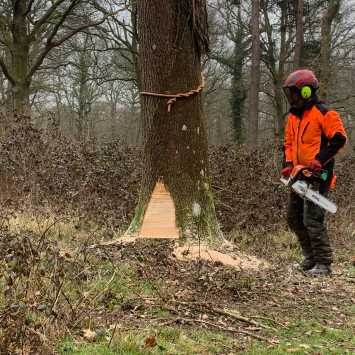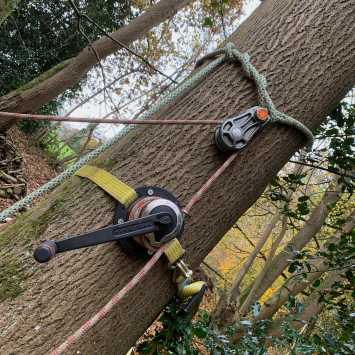What is it?
Assisted felling is a method of tree felling that involves placing a rope or winch wire above the cutting point and using a system to generate leverage in the desired direction. This technique can either reduce the manual effort required for traditional methods or enable the movement of larger trees that are not possible to fell with basic tools. Additionally, safety considerations may require the use of assisted felling in cases where hitting wedges or being under the tree during felling is not recommended, such as when dealing with dead or diseased trees.
This blog outlines my introduction to these methods over 20 years ago, the key benefits and hazards around assisted felling, and how a range of systems might be organised and applied to felling scenarios and their relative merits. Additionally, I will provide information on the typical pulling forces involved in assisted felling based on measurements taken during a course at Wakehurst Place, which will help to illustrate the relative merits of these systems.
We deliver this Lantra Awards training course and Benchmark Assessment over a 2-3 day duration and it logically follows on from basic chainsaw maintenance, crosscutting and felling up to 380mm units which are the course pre-requistes. The key components of the training are:
- Understanding the range of assisted felling operations available
- Health & Safety legislation applicable, especially PUWER.
- Build a compatible rope based system
- Deploy a wire rope based system
- Select and make appropriate cuts to compliment assisted felling techniques
The City & Guilds NPTC / Lantra Awards take is that assisted felling is about reducing the effort to generate similar forces than might be achieved using conventional tools, yet in commercial arboricultural and forestry situations these techniques are more likely to be deployed to significantly increase the leverage forces.
Assisted felling might comprise:
- Rope based system, (3:1 mechanical advantage)
- Powered rope based, drum or capstan
- Hand winch, (tirfor)
- Powered winch, (motor or tractor PTO or hydraulic)
While it may seem like a simple solution to attach a rope to a tree and have the ground crew pull or use a tracked chipper to remove the tree, there are potential issues with both approaches. Ground crew pulling a rope can work if there is enough distance and communication between operators, but problems may arise from debris falling on the crew or over tensioning causing tree failure.
The preferred method is to redirect the pulling line back to a position that allows a one person operation in making felling cuts and applying pulling force.
My background to Assisted Felling methods
Approximately 23 years ago, I participated in a workshop at Merrist Wood College. The workshop was conducted by Ken Palmer from Arbormaster, a US-based company, with assistance from Treevolution. It was an exceptional event that showcased innovative arboricultural training, techniques, and ideas. Back then, knowledge transfer was limited, and if you wanted to learn about practical treework, you had to order a book from Richmond's and read about it.
This event was pivotal in bringing a more intelligent approach to my treework, I was inspired by the ideas, people and kit - indeed I went on to spend time with Paolo who at the time had to do some furious GRCS winching to tension up a haul back speed line. These were the main components of the Arbomaster event;
- Assisted Felling using double pulleys to generate 5:1 mechanical advantage
- GRCS – yes it really has been around a while
- Load cell to measure rigging forces
- Speedline – haul back
Following this we ordered a couple on Kong double pulleys and regularly used them to make a portable and cost effective solution to pull over standing stems following canopy removal or whole trees. They accepted up to a 16mm double braid line and have a flat base which enable a prussic to be configured and pretension captured, this was ideal for out typical 2 or 3 person teams of that period.
- A 2 person team each generating a approximately 100kg or 1kN of pull could develop around 5 x that so;
- 2 person pull with a 5:1 mechanical advantage set up - 2kN x 5 = 10kN
Knowledge gap
There is an interesting paradox in the available information relating to assisted felling forces. Data and knowledge is extensive on potential winch & hauling system power, the impact of different system configuration, how angles affect forces on anchor points but strangely no information on the pulling force required to move trees of different sizes and degrees of lean.
Benefits of AF
- Reduced manual handling & input to achieve the same leverage force as conventional wedges.
- Remote operation possible out of potential drop zone
- Higher forces achievable, able to move trees with significant leans/back weight
- Smaller team required with progress capture
Hazards of AF
- Insufficiently long pulling system puts operators in drop zone
- Over tensioning creates risk of tree failure – barbers chair
- Hinge failure leads to loss of directional control – especially side leans
- Hinge failure pulls tree off stump forward – complete collapse
- Safer, machine based solution avoided
| Assisted Felling System | Pull capacity kg | Features & benefits | Drawbacks |
|
Rope based 3:1 Rope based 5:1 |
300kg 500kg |
Flexible modular system. Basic kit comprises rope, single & double pulleys, karabiners, prussic cord & anchor slings. Rope needs to be long enough. Can be stored & carried into site in a rope bag. | Modest pulling capacity, needs high anchor placement to create leverage. Friction losses in pulleys. Progress capture not as easy as machine based system. |
| Traction winch – 200/300/GRCS |
200kg
300kg 500kg |
Light & portable, easy operation by one person due to self tailing rope jaw. | Relatively expensive solution. Needs a tree stem to mount & redirect pulley above. May end up using 3:1 to build up pulling force. |
| Portable Capstan Winch | 1200kg | Modular, easily transported to site by 1-2 people. Long rope can be utilized offering range of options such as safe distances, redirects and mechanical advantage to build up pulling power. Can integrate choker chains to reduce wear and tear on vulnerable fabric components. |
Costs, use of rope at a modest safety factor and fabric vulnerable to damage. Can store energy creates a risk if anchor fails.
|
| Portable Drum winch DOCMA VF155 | 1485kg | 20m/min 80m rope automatic brake 5mm dynema rope | Cost, care needed in handling & set up. Difficult to back off a tensioned line gradually. |
| Tirfor T516 Hand winch | 2800kg | Robust components and high pulling capacity. Relatively simple and reliable operation. | Slow winching speed. Heavy to carry into site. Cable often too short to give adequate safe distances or redirect back behind chainsaw operator position |
| Krpan 5 Tractor 3point linkage winch. | 5000kg | Powerful, fast & easy to position in forestry sites. High stability of tractor unit where correctly matched |
Significantly more expensive than any other system, only available to those with tractor availability. Accessibility limited in dense understory.
Articulating alpine tractors can be unstable not positioned carefully. |
Case study - Assisted felling with Harken Traction 200 winch
Arborists who use the GRCS rigging device or other similar rigging products, like the LD2, LD2, SmartWinch, and ATD-Winch, will likely be acquainted with Harken winches. These winches have gained familiarity in the field due to their reliable performance and effectiveness in various rigging applications.
The winches are available in different sizes related to their pulling capacity and rope diameter compatibility. Some have two-speed operation giving a higher or lower mechanical advantage.
On the GRCS the winch is mounted onto aluminum plate that slots into a steel frame, this frame having been strapped to a tree base (this modular construction facilitates much easier handling and mounting). The rope entry point is vertical via the steel cleats, and critically the rope needs to enter these with minimum deflection. A minor redirect above and be used in a conventional rigging set up where the device is placed on the tree being removed, or a 90 degree redirect can be used if the device is positioned remotely and say a nearby tree stem.
This idea sets the scene for a new range of Harken products that can be directly mounted on a suitable tree stem or other flat surface to create a handy self-tailing pulling force.
Oak stem fell following sectional removal
We have just completed a rigging workshop where we took down two oak trees and left 8m stems. One of the trees had a slight back lean, so I used a ratchet strap to set up the winch on the tip of the previously felled stem. To redirect the 12mm teufelberger Sirius rigging line into the winch, we utilized a small pulley because the rope fairlead was not in line. This created a 3:1 system, increasing the pulling power.
Due to time constraints and the students needs we didn’t get onto rigging applications such as load transfer line, however from the other set ups it’s obvious the winch would be ideal for that type of work giving precise control, reasonable pulling power and requiring minimal manpower with the self tailing feature.
Coppice ash assisted felling
A client needed about 20 ash trees felled in a confined former quarry section of their woodland garden. This job required a carefully planned felling sequence to minimize hang ups and gradually increase available felling space with a range of ash trees in poor condition.
High anchor points in the target trees were set using a throw line at around 18-22m. The 12mm teufelberger rope was positioned in line with the intended felling direction and then redirected back to the felling area using a pulley and sling on either another tree or a previously felled stump. The winch was set up just behind the felling position with a block above to achieve favorable rope entry into the fairlead.
With this high anchor point and leverage it was easy to move the trees to overcome the backward lean. Where the felling direction was 180 degrees to the lean the winch pulled the trees reasonably accurately.
Where there was a side lean the trees fell faster than the winch could take in and often went off the desired felling direction. Perhaps the speed could be increased with a drill powering the winch?
We also tested the winch out with much lower placed anchor points, this offered lower leverage against the back lean, but had the advantage of less line to move through and the ability to follow through on the pulling that was less of an option on the initial trees. This method seemed to work well but it would be safer to have a higher capacity winch to make up for the loss of leverage.
The winch works well when there are plenty of adjacent trees of sufficient diameter to mount onto. With a block directly above to line up with the fairlead and line towards another redirect back to the target tree this offers a reasonably fast set up and high level of control pulling.
I really liked the benefits over a 3:1 or 5:1 line hauling approach of self tailing and quite precise load application – it was easy to gradually and carefully increase the pulling force prior to making any felling cuts, and was more of a one person operation. Mounted on a suitable tree the winch was stable.
It was less easy to work when there was a lack of suitable anchor points. A low hedgerow tree would allow a conventional winch or rope 3:1 to be anchored, but did not suit the traction winch.



